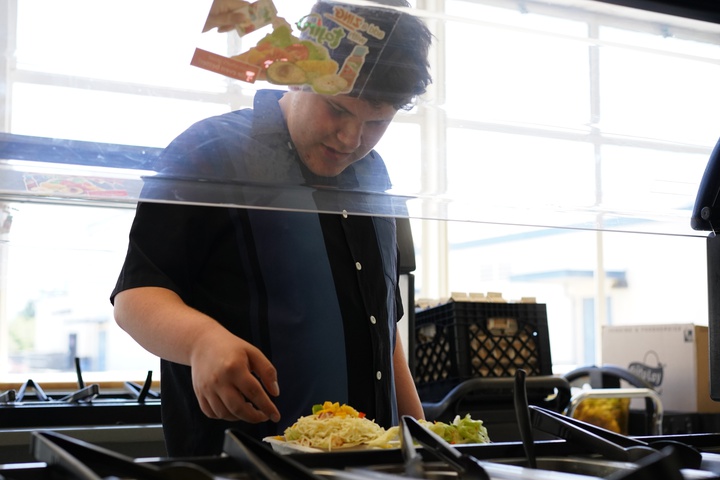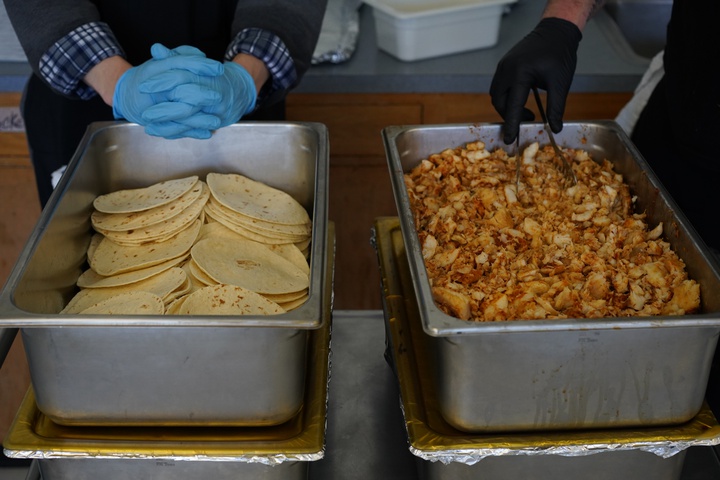Jessica Cejnar Andrews / Monday, June 3, 2024 @ 3:07 p.m.
Sea-to-Market Project Brings Local Seafood to Del Norte High, With Plans To Expand Next Fall

A Del Norte High School student tops his fish taco on Thursday. | Photo courtesy of Michael Hawkins
Josh Mims didn’t need a QR survey to tell him that the students at Del Norte High School liked his fish.
Working with the owner of the F/V Sea Chicken, Mims delivered 300 pounds of whole black snapper to DNHS on Thursday. They filleted it, baked it, flaked it and folded it in tortillas with mango salsa.
By about 12:15 p.m., they dished out roughly 100 pounds of fish.
“It was caught in Crescent City,” Mims told the Wild Rivers Outpost. “And the cool thing about sourcing locally is we reduce the carbon footprint of that fish by 30 percent.”
Mima is with the Community Food Council’s Sea-to-Market Project. Created with the goal to keep locally-caught seafood in Del Norte County, the program is still working on establishing an avenue to allow fishermen to offer their catch directly to consumers.
In the meantime, Mims said, he became acquainted to Del Norte Unified School District Superintendent Jeff Harris, who in turn put him in touch with Nutrition Services Director Julie Clark.
In addition to working with DNUSD, Mims and the Food Council has partnered with the Del Norte Commercial Fisherman’s Marketing Association.
“Our biggest linchpin right now is cold storage — there’s not enough cold storage to successfully scale this up, and that’s something we’re working on,” he said. Right now the school district is providing cold storage at their central freezer for a little bit of fish next year, but they can’t hold large volumes.”
Del Norte High’s fish taco bash served as an introduction of the Sea-to-Market Project to local students. Throughout the summer, fishermen will catch what the district will need and store it in freezers for its use during the 2024-25 school year, Mims said.
When classes resume, Mims will start testing the Sea-to-Market Project at the K8 level.
“We’re not going to do full-blown meals,” Mims said. “We’ll have samples in the K8 schools to see what those grade levels think about it."
He envisions panko-parmesan encrusted fish nuggies.
Mims said he’s looking at three to four boats to provide the fish for next year’s trial run. If it’s successful, DNUSD has discussed doubling the amount it purchases for the 2025-26 school year. And if that’s well received, there are discussions about the district potentially phasing out its canned tuna for locally caught tuna, Mims said.

Crescent City-caught black snapper starred in Del Norte High School's fish taco lunch Thursday, which was meant to highlight locally-caught seafood. | Photo courtesy of Michael Hawkins
Between a closed ocean and in-river salmon fishery, new regulations governing groundfishing and a shortened Dungeness crab season, Del Norte fishermen have faced an especially challenging year. Mims said one of the Sea-to-Market Project’s goals is to create more opportunity for the fishing fleet.
He noted that the Community Food Council’s deal with Del Norte Unified doesn’t interfere with seafood purchasers like Pacific Choice or Global Seafoods.
Mims, who is also part of the Redwood Region R.I.S.E. program’s Blue Economy panel, said he’s working with representatives in the Humboldt County Office of Education and has been in communication with similar officials from Mendocino, Sonoma and Lake counties. His goal is to expand the Sea-to-Market Project, to have “local boats feeding local folks.”
“Humboldt is very on board. Sonoma is pretty excited about it and Mendocino is very excited about it since they have the harbor in Fort Bragg,” Mims said. “I’m making this clear to everybody, I want local boats feeding local folks. I’m not looking to get Crescent City seafood down into Humboldt.”
The seafood is better quality than anything shipped from outside of the area and stored frozen for about nine months, said Mims, whose daughter goes to Del Norte High. He also noted that it’s a good introduction for high school students to commercial fishing as a career.
Eventually, Mims said, he sees the Sea-to-Market Project potentially launching a series of career-technical-education classes — everything from an introduction-to-fisheries to regulation enforcement.
“We’re currently combatting the graying of the fleet, there’s not a lot of young blood coming in and a lot of old guys going out,” he said.
CLICK TO MANAGE